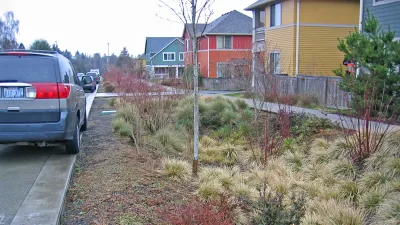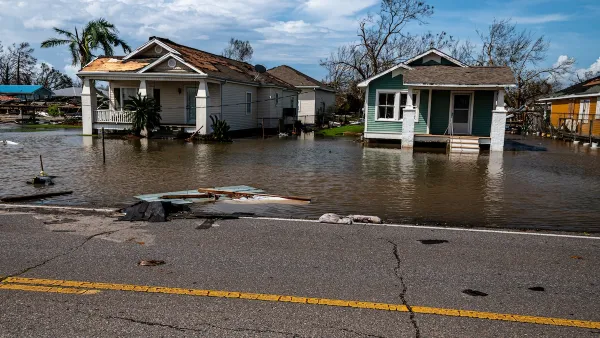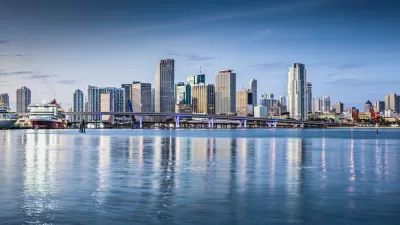A new Urban Land Institute Report details the increasing implementation of citywide green infrastructure networks, including investments on both public and privately owned sites.

Catastrophic floods. Withering droughts. Combined sewer overflows. As the planet warms, communities are coping with a range of ever-more-severe water challenges. Green infrastructure is part of the solution: many local governments are deploying natural features to manage water, while creating valuable green spaces in the bargain. And—according to a new report by the Urban Land Institute [pdf]—the private sector is increasingly on board.
Green infrastructure [pdf] offers a cost-effective alternative to traditional “gray” drainage systems, such as pumps and pipes. It’s a catchall term that includes rain gardens, bioswales, and green roofs that help manage stormwater and prevent sewer overflows. Also included are water-conservation strategies such as cisterns and rainwater recycling, which can mitigate the effects of drought. The benefits of this approach are manifold, from improved air and water quality to better climate resilience [pdf] and good-paying jobs for low-skilled workers.

For years, local governments have embraced green infrastructure on public land, and many have used mandates and incentives to encourage its uptake on private property. Those efforts have borne fruit. Today, we see the emergence of coordinated citywide green infrastructure networks that include both public and privately owned sites. Municipalities incorporate green design into public spaces, buildings, and rights-of-way, while the private sector does the same for privately owned buildings, open spaces, and roofs. For developers, there is much to be gained: according to the ULI report, green infrastructure projects “create value for real estate projects by enhancing aesthetics, operational efficiency, and building user experience.”
The report examines several compelling examples:
- Burbank Water and Power EcoCampus, Burbank, California—a campus for a community-owned utility site, which is the first power plant in the world to run on 100 percent recycled water;
- Canal Park, Washington, D.C.—a neighborhood park developed by a public/private partnership and located on the site of a former D.C. waterway, with 95 percent of the park’s irrigation, fountain, toilet-flushing, and ice-rink water provided through rainwater recycling;
- Encore!, Tampa, Florida—a 28-acre public/private, mixed-use, mixed-income development with an 8,000-square-foot stormwater retention harvesting system and a stormwater vault designed as the centerpiece of a public park;
- Stonebrook Estates, Harris County, Texas [pdf]—a Houston-area residential development with a low-impact development approach that stood up to catastrophic flooding during the Tax Day floods of 2016.
These and similar green infrastructure projects offer benefits to all partners. For cities, they save money that would otherwise be spent on costly gray infrastructure that offers no community benefits (you can’t picnic in a storm sewer). There can often be cost savings for real estate developers, too, or opportunities for increased yield, because green infrastructure takes up less space than traditional stormwater approaches, such as detention ponds—freeing up more space for development. The study also found that green infrastructure can offer opportunities for placemaking and enhancing aesthetics, ultimately leading to a marketing advantage and the potential for unique market positioning.

Perhaps the best argument for public-private cooperation on green infrastructure is that neither sector, on its own, can manage today’s water challenges. And, in a changing climate, those challenges will only multiply. The ULI report quotes Jeffrey Seltzer, associate director of the Washington, D.C. Department of Energy and Environment: “When we look at the amount of work that needs to be done to manage stormwater in the District—the vast area of public and private land that needs to be retrofitted as well as the money and time involved—we realize that we can’t accomplish our water quality goals by only implementing public projects. Incentive programs that encourage voluntary retrofit are a huge piece of the puzzle.”
The good news is that the private sector is stepping up to that challenge and creating opportunities as a result.
Katharine Burgess is senior director of the Urban Resilience Program at the Urban Land Institute. An urban planner with experience working in the U.S., U.K., and Germany, she began her career managing design workshops after Hurricane Katrina.

Planetizen Federal Action Tracker
A weekly monitor of how Trump’s orders and actions are impacting planners and planning in America.

Vehicle-related Deaths Drop 29% in Richmond, VA
The seventh year of the city's Vision Zero strategy also cut the number of people killed in alcohol-related crashes by half.

As Trump Phases Out FEMA, Is It Time to Flee the Floodplains?
With less federal funding available for disaster relief efforts, the need to relocate at-risk communities is more urgent than ever.

Judge Reverses Federal Funding Freeze for EV Infrastructure
A federal judge ordered the Trump administration to release funding for the National Electric Vehicle Infrastructure Program, a $5 billion program aimed at improving charging infrastructure.

Santa Monica May Raise Parking Permit Fees
The city says the changes would help better manage curb space and support its sustainability goals.

Portland Housing Bond Created Nearly 5,000 Units, But Affordability Remains Out of Reach
Despite better-than-expected results from multiple local housing bonds, housing costs and homelessness remain top of mind for many Oregonians.
Urban Design for Planners 1: Software Tools
This six-course series explores essential urban design concepts using open source software and equips planners with the tools they need to participate fully in the urban design process.
Planning for Universal Design
Learn the tools for implementing Universal Design in planning regulations.
JM Goldson LLC
Custer County Colorado
Sarasota County Government
City of Camden Redevelopment Agency
City of Astoria
Transportation Research & Education Center (TREC) at Portland State University
Camden Redevelopment Agency
City of Claremont
Municipality of Princeton (NJ)





























